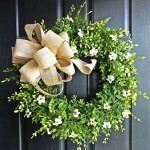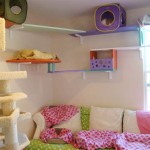How To Decorate Your House With Fake Plants And Flowers
Artificial plants and flowers, often referred to as faux botanicals, have evolved significantly in recent years. No longer relegated to dusty corners and obviously artificial appearances, contemporary artificial foliage offers a realistic and versatile option for interior decorating. Their appeal lies in their low maintenance requirements, longevity, and the ability to introduce greenery and floral accents into spaces where live plants may struggle to thrive. This article provides a comprehensive guide on effectively incorporating artificial plants and flowers into your home decor, focusing on strategic placement, selection criteria, and techniques to enhance the overall aesthetic.
The successful integration of artificial plants and flowers hinges on thoughtful planning and execution. Avoid simply scattering faux foliage randomly throughout the house. Instead, consider the architectural style of your home, the existing color palette, and the intended mood of each room. A cohesive approach will result in a more polished and deliberate look. Before purchasing any artificial plants or flowers, take measurements of the spaces where they will be placed. This will help to ensure that the size and scale of the faux botanicals are appropriate for the designated area.
Furthermore, consider the lighting conditions within each room. Although artificial plants do not require natural light for survival, simulating natural light can enhance their realism. Placing faux plants near windows or supplementing with strategically placed artificial lighting can contribute to a more convincing and visually appealing display. The goal is to create an illusion, mimicking the natural growth patterns and light requirements of live plants as closely as possible.
Choosing High-Quality Artificial Plants and Flowers
The key to avoiding the "obviously fake" look lies in selecting high-quality artificial plants and flowers. While budget-friendly options may be tempting, investing in more realistic-looking varieties will ultimately result in a more sophisticated and lasting impression. Look for materials that mimic the texture and color variations of real foliage. Silk and high-grade plastic are common materials used in quality artificial plants and flowers. Examine the details closely, paying attention to the veining of leaves, the subtle color gradations, and the overall construction of the piece.
Consider the construction of the stems and branches. Realistic artificial plants often feature pliable stems that can be adjusted to create a more natural-looking arrangement. The presence of artificial "soil" or moss in the base of the plant can also contribute to its authenticity. Avoid plants with obvious seams, frayed edges, or a uniform, unnatural color. The goal is to find artificial plants that are convincing enough to blend seamlessly with your existing decor and withstand close scrutiny.
When choosing artificial flowers, pay attention to the quality of the petals and the overall shape of the bloom. Realistic artificial flowers will often have subtle variations in color and texture, mimicking the imperfections found in nature. Consider the seasonality of the flowers you choose. Displaying out-of-season blooms can detract from the overall realism. Opt for classic flowers like roses, lilies, or orchids, which are readily available in high-quality artificial versions, or select foliage that aligns with the current season, such as autumn leaves or spring blossoms.
Strategic Placement and Arrangement Techniques
The placement of artificial plants and flowers is crucial to achieving a natural and aesthetically pleasing look. Consider the architectural features of your home and use faux botanicals to highlight or complement existing elements. For example, a tall artificial tree can be placed in a corner to add height and visual interest to a room. A trailing artificial vine can be draped over a bookshelf or mantelpiece to soften hard edges and create a sense of movement. Artificial flowers can be used to brighten up a coffee table, add a touch of elegance to a dining room, or create a welcoming ambiance in an entryway.
Grouping artificial plants and flowers in odd numbers tends to be more visually appealing than even numbers. This arrangement creates a more organic and asymmetrical look, mimicking the natural growth patterns of plants. Consider the height and texture of the plants when creating a grouping. Varying the height and texture will add depth and visual interest to the arrangement. Use different types of containers to add further visual appeal. Varying the container style and material can enhance the overall aesthetic and complement the style of the plants.
When arranging artificial flowers, consider the principles of floral design. Create a focal point with a larger bloom or a cluster of flowers, and use smaller flowers and foliage to fill in the gaps and create a sense of balance. Vary the height and angle of the stems to create a more natural-looking arrangement. Avoid arranging the flowers in a perfectly symmetrical or uniform manner. The goal is to create a display that looks effortless and organic.
For larger artificial plants, consider the size and scale of the room. A large artificial tree may overwhelm a small space, while a small potted plant may get lost in a large room. Choose plants that are proportionate to the size of the room and the surrounding furniture. Use strategic placement to create focal points or to fill in empty spaces. For example, a tall artificial plant can be placed in a corner to add height and visual interest to a room.
Maintaining the Realism of Artificial Plants and Flowers
Maintaining the appearance of artificial plants and flowers is essential to preserving their realism and longevity. Dusting is the most important aspect of maintenance. Over time, dust can accumulate on the leaves and petals, dulling their color and detracting from their realism. Use a soft cloth, a feather duster, or a can of compressed air to remove dust regularly. Pay particular attention to the undersides of leaves and the crevices of flowers, where dust tends to accumulate. A gentle cleaning with a damp cloth and mild soap can also be used to remove stubborn dirt or stains. Ensure the plants are completely dry before placing them back in their display location.
Avoid exposing artificial plants and flowers to direct sunlight for extended periods of time. While they do not require sunlight for survival, prolonged exposure to UV rays can cause the colors to fade over time. If possible, place artificial plants and flowers away from direct sunlight, or use UV-resistant sprays to protect them from fading. Rotate the plants periodically to ensure even exposure to light and prevent fading on one side.
Re-fluffing leaves and petals can help to maintain the shape and appearance of artificial plants and flowers. Over time, the leaves and petals may become flattened or misshapen due to storage or handling. Gently manipulate the leaves and petals to restore their natural shape and fullness. Use floral wire or tape to secure any loose leaves or stems. Replacing artificial soil or moss can also help to refresh the appearance of artificial plants. Over time, the artificial soil or moss may become faded or discolored. Replace it with fresh materials to restore the realism of the plant.
Consider storing artificial plants and flowers properly when they are not in use. Store them in a cool, dry place away from direct sunlight. Wrap delicate blooms in tissue paper to protect them from damage. Use storage containers or bags to prevent dust accumulation. Proper storage will help to prolong the lifespan of artificial plants and flowers and keep them looking their best.
By following these guidelines, homeowners can effectively decorate their homes with artificial plants and flowers, creating a beautiful and inviting space that requires minimal maintenance. The key is to prioritize quality, choose strategic placement, and maintain the plants' appearance to ensure a convincing and aesthetically pleasing result.

How To Style Decorate With Artificial Flowers Plants

How To Decorate With Fake Plants And Where Find The Best Faux Greenery House By Hoff

Decorate With Flowers Use These Artificial For Home Decoration

How To Decorate Your Home With Artificial Plants Ferns N Petals

How To Tastefully Decorate With Fake Plants And Greenery Calypso In The Country

How To Style Decorate With Artificial Flowers Plants Plant Decor Tropical Home

How To Style Decorate With Artificial Flowers Plant

How To Decorate With Faux Flowers And Greenery In Winter Sanctuary Home Decor

How To Style Decorate With Artificial Flowers Plants Setting For Four Interiors

Artificial Flower Fake Plants Wall Hanging Decor For Wedding Romantic Living Room Hotel Dedroom Decoration







